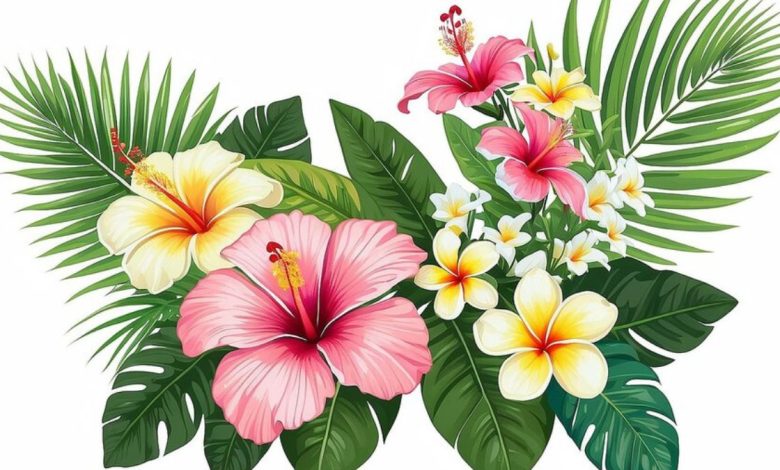Hawaiian Flowers: A Blooming Paradise of Beauty and Tradition
Hawaiian Flowers: A Blooming Paradise of Beauty and Tradition

Introduction to Hawaiian Flowers
Hawaii’s lush environment, tropical climate, and fertile volcanic soil create the perfect conditions for a diverse range of flowers to flourish. From the high peaks of Mauna Kea to the warm coastal areas, different types of flowers thrive, making Hawaii an oasis for botanists and flower enthusiasts alike. Hawaiian flowers have become symbols of the islands themselves, representing love, beauty, and the spirit of aloha.
Let’s explore some of the most iconic and beloved Hawaiian flowers and what they mean to the people of the islands.
History and Cultural Significance of Hawaiian Flowers
Hawaiian flowers have been integral to Hawaiian culture for centuries. From ancient times, they have been used in religious ceremonies, celebrations, and daily life. Flowers are deeply embedded in Hawaiian traditions, with their meanings passed down through generations.
One of the most recognized uses of flowers in Hawaiian culture is the lei. Traditionally, leis are garlands made of flowers, leaves, seeds, and even feathers. They are given to people as a gesture of respect, love, or welcoming. Leis are worn during important occasions like weddings, graduations, and religious ceremonies. Each flower used in a lei has its own meaning, making the gift of a lei even more symbolic.
The State Flower: Hibiscus
The yellow hibiscus (Hibiscus brackenridgei) holds the prestigious title of Hawaii’s state flower. This bright, showy bloom captures the essence of Hawaii with its large, trumpet-shaped petals and bold yellow hue. The hibiscus is native to the Hawaiian Islands, and though the yellow variety is the official state flower, hibiscus plants bloom in a rainbow of colors, including red, pink, and white.
The hibiscus symbolizes delicate beauty and is often associated with fleeting moments, as the flowers usually bloom for just one day. Despite their brief life, they leave a lasting impression with their radiant beauty, much like the spirit of Hawaii itself.
Plumeria: The Fragrant Blossom
Another beloved flower in Hawaii is the plumeria (Plumeria rubra). Known for its intoxicating fragrance and soft, waxy petals, the plumeria is a popular flower for making leis. The plumeria blossoms in shades of white, pink, red, and yellow, and its delightful scent can be found filling the air around homes, parks, and beaches throughout the islands.
Plumeria trees are commonly seen growing in Hawaiian gardens, and the flower represents positivity, new beginnings, and peace. Interestingly, the plumeria is not native to Hawaii, but it has become an iconic part of the islands’ floral landscape, treasured for its scent and beauty.
Bird of Paradise: Nature’s Tropical Masterpiece
The Bird of Paradise (Strelitzia reginae) is a striking and unusual flower that looks as if it belongs in a tropical painting. Named for its resemblance to a brightly colored bird in flight, this exotic flower is native to South Africa but thrives in Hawaii’s tropical environment.
With its brilliant orange and blue petals, the Bird of Paradise stands tall and proud, adding a dramatic flair to Hawaiian gardens. The flower symbolizes joy, freedom, and paradise, making it a popular choice in Hawaiian landscaping and floral arrangements.
Ohia Lehua: A Flower of Legend
The ohia lehua (Metrosideros polymorpha) is one of the most significant flowers in Hawaiian culture and folklore. This native Hawaiian plant grows in some of the most challenging environments, including barren volcanic landscapes. Its bright red blooms are known as lehua, and the plant itself has a strong association with Hawaiian legends.
According to Hawaiian mythology, the ohia lehua is tied to the story of Pele, the volcano goddess, and her lover, Ohia. When Pele could not win over Ohia’s heart, she turned him into a twisted tree. Ohia’s love, Lehua, was so heartbroken that the gods transformed her into the lehua blossom to be reunited with Ohia. It’s said that picking the lehua flower will cause rain to fall, symbolizing the tears of Lehua.
Beyond its mythological importance, the ohia lehua is an essential species in Hawaii’s ecosystems. It is often one of the first plants to grow on new lava flows, helping to establish life in the aftermath of volcanic eruptions.
Tuberose: The Nighttime Perfume
The tuberose (Polianthes tuberosa) is a white, tubular flower known for its powerful fragrance that becomes more intense at night. Native to Mexico, the tuberose has made its way to Hawaii, where it has become a popular addition to leis and floral arrangements.
Its heavenly scent has made tuberose a favorite flower for Hawaiian weddings and other celebrations. The flower represents purity, love, and sensuality, making it a fitting choice for romantic occasions.
The Exotic Anthurium
Anthuriums are among the most exotic-looking flowers found in Hawaii. With their shiny, heart-shaped leaves and bright red, pink, or white spathes (the colorful part of the plant often mistaken for a flower), anthuriums are show-stopping plants that thrive in Hawaii’s humid climate.
Originally from Central and South America, anthuriums have found a second home in Hawaii, where they are cultivated for their stunning appearance and longevity. Anthuriums symbolize hospitality, making them a common gift for welcoming guests.
Cultural Practices Involving Flowers
Flowers in Hawaii are not just admired for their beauty—they are a key part of Hawaiian life and cultural practices. For example, flowers are used in hula, the traditional Hawaiian dance. Dancers often wear flower leis and adorn their hair with blossoms, adding grace and vibrancy to their performances.
Another cultural practice involving flowers is the decoration of homes and temples. Many Hawaiian households have altars where flowers are offered as a sign of respect to ancestors and gods. The beauty and fragrance of the flowers are believed to please the spirits and bring good fortune.
Floral Tourism in Hawaii
Hawaii’s flowers attract thousands of visitors each year who come to experience the islands’ natural beauty. Botanical gardens like the Lyon Arboretum on Oahu and the Hawaii Tropical Botanical Garden on the Big Island showcase the incredible diversity of Hawaiian flora.
Visitors can also enjoy flower festivals such as the annual Merrie Monarch Festival, where hula competitions are complemented by elaborate flower displays and lei-making contests. These festivals celebrate Hawaii’s cultural heritage and highlight the islands’ connection to nature.
Hawaiian Flower Symbolism and Meanings
Every Hawaiian flower has its own unique symbolism. Understanding the meanings behind these flowers can enhance the appreciation of Hawaii’s floral wonders. Here are a few examples:
- Hibiscus: Delicate beauty, fleeting moments, and the essence of Hawaii.
- Plumeria: Positivity, new beginnings, and peace.
- Bird of Paradise: Joy, freedom, and paradise.
- Ohia Lehua: Strength, resilience, and the spirit of love and legend.
- Tuberose: Purity, love, and sensuality.
- Anthurium: Hospitality and abundance.
Environmental Importance of Hawaiian Flowers
Beyond their aesthetic and cultural value, Hawaiian flowers play a crucial role in the islands’ ecosystems. Native species like the ohia lehua are vital for maintaining soil health and providing habitat for local wildlife. These plants help protect against erosion and contribute to the overall balance of Hawaii’s natural environment.
Conservation efforts are in place to protect Hawaii’s unique flora from invasive species and habitat destruction. Organizations like the Hawaii Conservation Alliance are working to ensure that future generations can continue to enjoy the beauty and benefits of native Hawaiian plants.
Conclusion
Hawaiian flowers are much more than beautiful adornments; they are a reflection of the islands’ rich culture, history, and natural splendor. From the hibiscus to the ohia lehua, these flowers tell the story of Hawaii’s resilience, diversity, and timeless beauty. Whether you are visiting Hawaii to explore its botanical gardens or simply want to appreciate the flowers’ cultural significance, there is no doubt that these blossoms hold a special place in the hearts of those who call Hawaii home.
FAQs
- What is the most famous Hawaiian flower?
The hibiscus is the most famous Hawaiian flower and is the state flower of Hawaii. - What does the plumeria symbolize?
The plumeria symbolizes positivity, new beginnings, and peace in Hawaiian culture. - Are anthuriums native to Hawaii?
No, anthuriums are originally from Central and South America but have become popular in Hawaii due to their striking appearance. - What is the significance of the ohia lehua flower?
The ohia lehua is tied to Hawaiian mythology and represents strength, resilience, and love. - Can I pick flowers in Hawaii?
While it’s common to see flowers used in leis and decorations, it’s important to respect the environment and avoid picking flowers from protected areas or native plants like the ohia lehua.




